Although flavonoids or yeast have been used as feed additives to improve the production efficiency and health of adult cattle, little information is available on their effects on rumen fermentation in calves. The objective of this study was to investigate the effects of feed supplementation with mulberry leaf flavonoids and
Candida tropicalis on performance, blood parameters, and rumen fermentation characteristics during pre-weaning and post-weaning periods. Forty-eight Holstein calves were used in a four-groups trial and were supplemented with (1) no yeast or flavonoids (CON), (2) active dry yeast (ADY;
C. tropicalis, 5.0 × 10
9 CFU/d), (3) flavonoids (FLA; 3 g/d), or (4) yeast and flavonoids (YF;
C. tropicalis, 5.0 × 10
9 CFU/d; flavonoids, 3 g/d). The feeding strategy was as follows: milk replacer was offered at 12% of body weight in two meals per calf each day at age 21 d, and a gradual weaning process was adopted at age 50 to 56 days. Data of daily feed intake, body weight, and serum and rumen fermentation parameters were obtained at 28, 42, 56, and 80 d ages, respectively. A significant time effect and interaction between treatment and time was found for average daily gain, feed efficiency, total volatile fatty acid concentration, and proportion of propionate in calves (
p < 0.05). Average daily gain and feed efficiency increased during post-weaning and overall periods for calves in FLA and YF groups compared with CON and ADY groups (
p < 0.05). A reduction of fecal scores with supplementation was found in FLA and YF groups (
p < 0.05). Rumen fluid pH and ammonia nitrogen concentration remained constant across the groups, whereas total volatile fatty acid concentration and molar proportion of propionate significantly increased during the pre-weaning and overall periods in FLA and YF groups (
p < 0.05). Calves in YF group had the highest serum concentrations of IgG and IgA during the overall period (
p < 0.05). Additionally, serum β-hydroxybutyric acid concentration was higher in ADY and FLA groups during the post-weaning period (
p < 0.05). Supplementation with
C. tropicalis showed little effect on increasing growth performance and health compared with flavonoids alone. Meanwhile, the combination of
C. tropicalis and flavonoids was not synergistic with respect to improving health and rumen fermentation compared with use of flavonoids alone in pre- and post-weaning calves (
p > 0.05).
Full article






